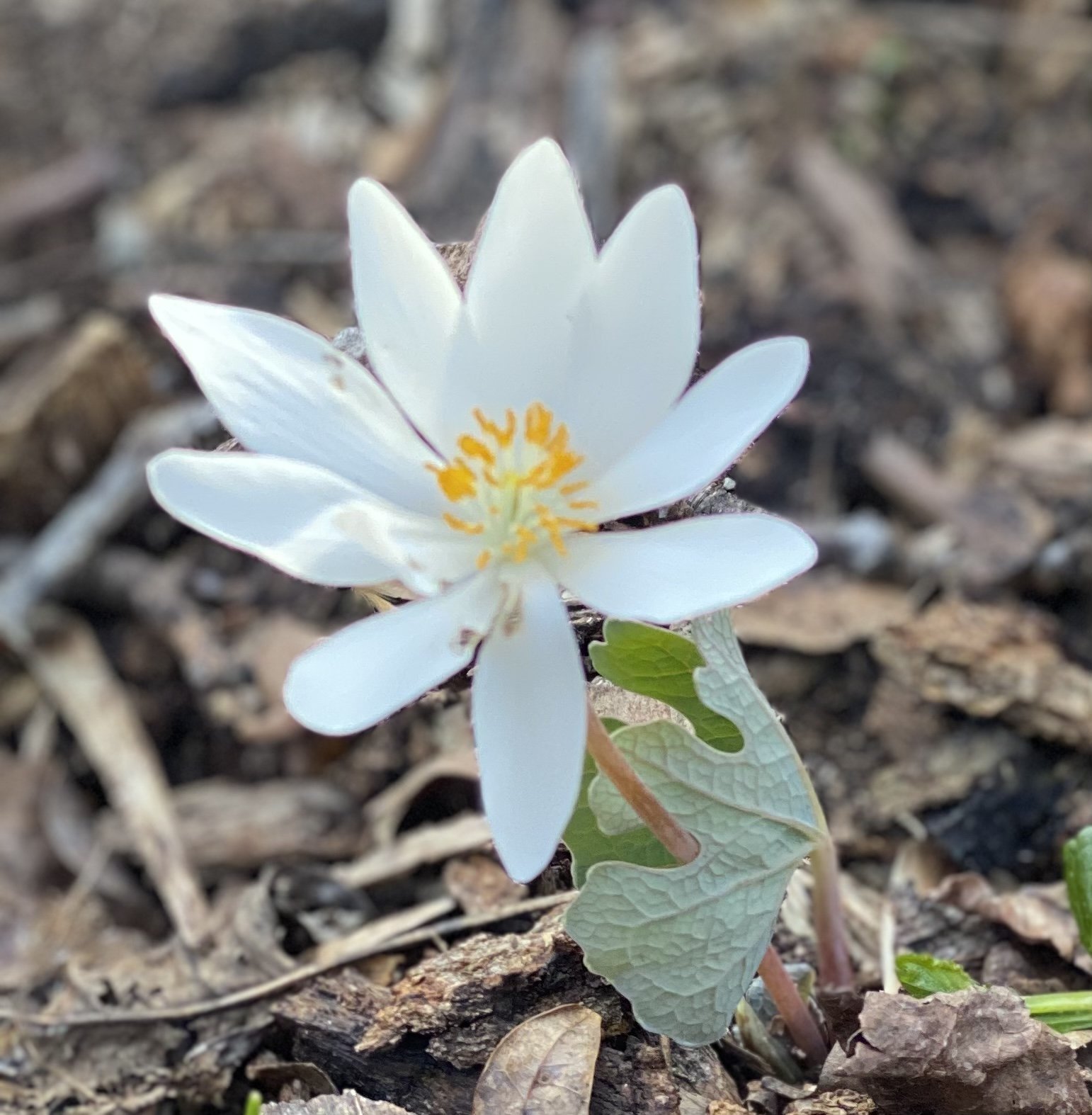It’s like the flower is stepping out of the bathrobe that is the leaf.
Plant of the Week:
Bloodroot
The Sanguinaria canadensis is one of the spring ephemerals that I want to have more of in my garden. I have a bit, but we are greedy gardeners who always want more, aren’t we? Just say yes.
The Bloodroot flower is so cheerful, and it unfurls from the one gray-green leaf so oddly that I find its entrance as part of the charm. You can see the red of the stem- not quite bloody, but certainly sanguine.
Guest
Kathy Jentz wears all the hats that one could as a garden communicator, and she has made our nation’s capital into her gardening province, with a magazine, Washington Gardener, a weekly podcast, GardenDC and now a book, called The Urban Garden. Coauthored with Teri Speight, The Urban Garden will give you 101 ways to grow food and beauty in the city. Literally!
Giveaway for The Urban Garden!
To enter, please do one of the following and shoot me an email to let me know what you did, and you will be entered!
Put one of my IG posts or reels on your story. Hope it’s a funny one!
Write a review of Into the Garden with Leslie on Apple podcasts
Sign up for my newsletter if you haven’t already.
COFFEE TIME!
Please consider supporting Into the Garden with Leslie my buying me a cup of coffee
OR! Becoming a member of I’m into the Garden too!
I will send you some LH Gardens gear if you become a member!
The Play List—
a list of garden things…
Where can I watch the Virginia Home Grown PBS television show that features LH talking about pruning?
What are some native spring ephemerals that we can add to our gardens?
What is Leycestaria formosa?
Will your emerging plants survive that inconvenient last blast of winter?
How and why do you deadhead bulbs?
Where can I watch the Virginia Home Grown PBS television show that features LH talking about pruning?
The show will always be accessible on Virginia Home Grown’s Facebook page, and you can have a look right here! I was amazed by the photography and editing— particularly the drone footage.
I come in about halfway through the hour long show, but the link is just me (and Keith, and a little of Ginny!). I talk about how to prune boxwoods and hydrangeas specifically, but I mention lots of general pruning tips.
Also, Ginny the English Spring Spaniel is featured!
What are some native spring ephemerals that we can add to our gardens? Besides the native Sanguinaria canadensis, or Bloodroot that is our Plant of the Week, I have two more on my list that I intend to shop for and they are the White trout lilies (Erythronium albidum) and Spring beauties (Claytonia virginica).
What is Leycestaria formosa? I love it when I run into a plant I have never heard of. This week when I was hunkering down by the fire during what I hope was winter’s last gasp, instead of actually gardening, I asked what people were doing in their gardens. Lots of great responses, including Tessa having a chat to her clematis, with the goal of making her other plants jealous. Lianne wrote me that she was potting up seedlings from a plant that I had not heard of and that intrigued me. Let’s be clear, there are SO many plants I don’t know, but I looked it up and maybe I need one of these. Here’s the skinny from MOBOT. Leycestaria formosa is a summer blooming shrub that flowers in mid to late summer, attracts hummingbirds, is deer resistant, has edible fruit, and you can make a whistle from the hollow plant stem.
No wonder Lianne is potting up seedlings!
Will your emerging plants survive that inconvenient last blast of winter? Short answer is yes. Anything that is emerging now is supposed to emerge now and survive the ‘now’ temperatures. It’s true that climate change is happening, but not fast enough to totally bamboozle plants— maybe just confuse them a tiny bit. I can see that I lost plenty of fat Hydrangea macrophylla buds, which is sad, but I will just get more excited about them next time I get a bumper crop. And I can see damaged leaves on early emerging hosta, and farfugium, (or ligularia. You say potato…) but not much else. Indoor plants and tiny summer seedlings— absolutely not, But hardy perennials, almost always yes, they can get through late spring frosts.
How and why do you deadhead bulbs? The HOW: You deadhead spring bulbs simply by removing the flower stalk, but only where the seeds would form. For a tulip, it’s quick snap and toss; for a daffodil, it’s almost as easy. Hyacinths have flowers all down the stalk, so you may want to use snips. I don’t even collect them for the compost pile— I just remove and toss into the bed.
Why do you deadhead flower bulbs? Dear Reader, for the same reason you deadhead any flower. Flowers put precious energy into making seeds because their endgame is to reproduce. If you remove the opportunity for them to make seeds, they put that same energy into roots and shoots, giving you a stronger and better plant, or in this case, bulb. But pray, never remove the foliage of a bulb until it withers on its own. That foliage feeds the bulb!
I just used my dirty little thumbnail to remove this spent daffodil flower.
Frost damaged foliage on an early emerging hosta. It will survive, and so shall I.
Or if your nails are more precious, grab some snips.









